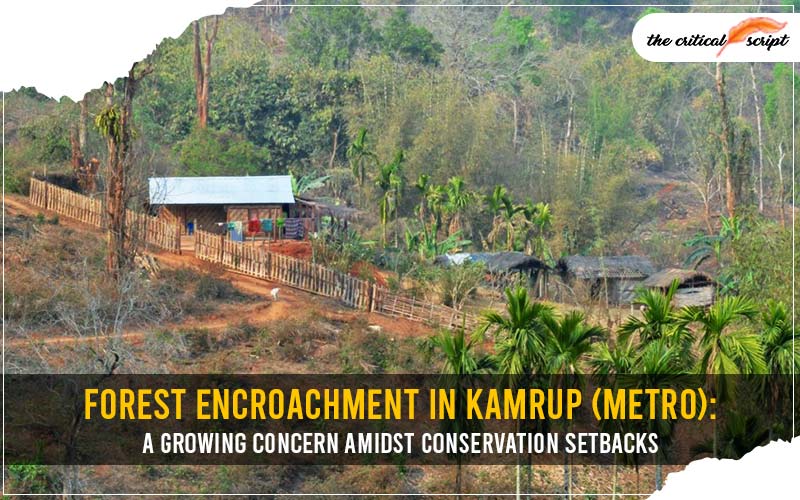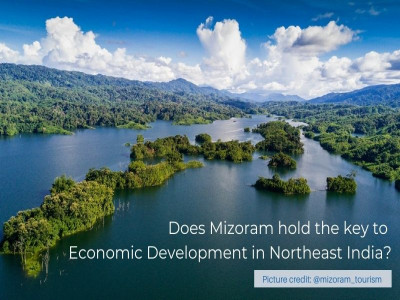
Forest Encroachment in Kamrup (Metro): A Growing Concern Amidst Conservation Setbacks
In recent years, forest
encroachment in Assam, particularly in the Kamrup (Metro) district, has become
an increasingly pressing issue with substantial environmental and social
consequences. The illegal takeover of forest lands has led to a reduction in
green cover, disrupting natural habitats, fueling man-animal conflicts, and contributing
to rising temperatures in the region. Despite periodic government eviction
drives, the problem persists, highlighting both regulatory gaps and the need
for more robust conservation efforts.
The Forest Landscape of Assam
Assam is home to diverse
forests, covering 34.21% of its geographical area. These forests, spread across
plains and hills, play a crucial role in regulating climate, preserving
biodiversity, and sustaining wildlife. However, data reveals that a significant
portion of these forests has been encroached upon for human settlement and
other purposes. Encroachments are most prevalent in densely populated areas,
such as Kamrup (Metro), which includes the state capital, Guwahati.
Kamrup (Metro) district alone
hosts 16 reserved forests, encompassing more than 35,329 hectares.
Unfortunately, large sections of these forests, including ecologically
important hills like Fatashil, South Kalapahar, Jalukbari, Gotanagar,
Hengrabari, Sarania, and Garbhanga, have been subjected to encroachment. Despite
sporadic government efforts to reclaim these lands, the encroachment continues
unchecked, especially within urban settings.
Impact on Wildlife and Climate
The rampant encroachment of
forests is directly linked to the rise in man-animal conflict across Assam. As
forests shrink, wild animals are forced to venture closer to human settlements
in search of food and shelter, leading to increased encounters and conflicts.
This trend is troubling not only for human safety but also for biodiversity
conservation, as rare and endangered species face shrinking habitats and
heightened threats.
The loss of forest cover also
impacts climate regulation. Forests play a critical role in absorbing carbon
dioxide and maintaining regional temperatures. With ongoing deforestation,
Assam has experienced unusual temperature spikes, including the hottest
September recorded this year. Rising temperatures and habitat loss together
contribute to an unstable climate, which could have long-term implications for
the environment and agriculture in Assam.
The Garbhanga Sanctuary Controversy
In 2022, the Assam government
declared 117 square kilometers of Kamrup (Metro) district as the Garbhanga
Wildlife Sanctuary, a decision celebrated by environmentalists and local
communities. Garbhanga, located in the eastern part of Kamrup district, is
known for its scenic beauty, rich biodiversity, and a unique mix of deciduous
and semi-evergreen forests. It is bordered by the Rani-Garbhanga Reserved
Forests and is home to various flora and fauna, making it a valuable ecological
zone.
However, in a surprising turn
of events, the government rolled back this sanctuary status in August 2023,
reverting Garbhanga to a reserved forest. This decision sparked widespread
criticism, with concerns that downgrading Garbhanga’s protection status could
open the area to further encroachment and illegal activities, ultimately
threatening its biodiversity.
Legal Action: A Step Toward Reinstating Garbhanga’s Sanctuary Status
The decision to revoke
Garbhanga’s sanctuary status prompted Guwahati-based environmental activist
SubratTalukdar to file a Public Interest Litigation (PIL) with the Gauhati High
Court, challenging the Assam government’s move. In response, a division bench
comprising Chief Justice Vijay Bishnoi and Justice N. Unni Krishnan Nair issued
notices to both the Government of India and the Assam government. The court has
granted three weeks for these parties to respond to the PIL, after which a
subsequent hearing will take place.
The legal case highlights a
critical debate: balancing development with environmental conservation.
Environmentalists argue that Garbhanga, with its rich flora and fauna, deserves
sanctuary status to safeguard it against human encroachment and protect the
ecological balance. Without this elevated status, Garbhanga is at greater risk
of being exploited, which could lead to severe ecological consequences in the
future.
Inadequate Eviction Drives and Policy Challenges
While the Assam government
conducts eviction drives sporadically, these initiatives have had limited
success in curbing encroachment in urban forest areas. For reasons often
unclear, eviction efforts tend to focus on rural or less visible forest areas,
leaving urban encroachments largely unaddressed. In Kamrup district alone, more
than 130 hectares of forest land are officially recorded as encroached upon,
though the actual extent may be much greater.
Moreover, the government’s
inconsistent policies, such as the Garbhanga reversal, reflect a broader
struggle to prioritize environmental protection amid development pressures.
Despite laws to protect reserved forests, enforcement remains weak, and
political and economic interests frequently influence decision-making.
Effective solutions will require both a stronger legal framework and increased
political will to enforce protections.
Why would the Govt. of Assam decide to roll back the status ?
Designating Garbhanga as a wildlife sanctuary would have imposed stricter regulations on land use and restricted certain developmental activities. The area around Garbhanga has seen growing urbanization, particularly with Guwahati’s expansion. Sanctuary status could have restricted infrastructural projects, making it challenging for the government to implement developmental initiatives in the region. The designation of a sanctuary brings additional administrative requirements, including stricter patrolling, resource allocation, and comprehensive ecological management.The recent trend of land acquisitions by the government, especially in ecologically sensitive areas, often sparks a debate about balancing development with environmental conservation. While land acquisition may be necessary for urbanization, infrastructure, and community welfare, it should not come at the cost of environmental degradation or biodiversity loss.
In the case of Garbhanga and similar areas, land-use decisions must be made with an awareness of their long-term environmental impacts. Without proper environmental assessments and safeguards, such acquisitions could lead to the destruction of crucial habitats, the depletion of natural resources, and the disruption of ecosystems. The rollback of the sanctuary status in favor of reserved forest status, while possibly aimed at accommodating development, could leave critical wildlife corridors vulnerable to encroachment and exploitation.
Public Activism and Environmental Awareness
The fight for Garbhanga’s sanctuary status has united citizens, students, and environmental organizations in Guwahati and beyond. Amidst this backdrop, the recent public campaign to protect the trees around Dighalipukhuri—an ancient lake and popular site in Guwahati—demonstrates a growing public interest in conservation. Local activism shows that citizens are increasingly aware of the importance of green spaces and are willing to mobilize for the protection of Assam’s natural heritage.
The Way Forward: Sustainable Solutions for Forest Conservation
Addressing forest
encroachment in Kamrup (Metro) and Assam as a whole will require a
multi-faceted approach:
- Strengthened Legal Protections: Reinstating
Garbhanga’s sanctuary status could serve as a precedent for safeguarding
other vulnerable forest areas. Implementing strict legal protections for
forests and strengthening penalties for encroachment are crucial steps.
- Regular and
Targeted Eviction Drives: The government needs to conduct frequent,
unbiased eviction drives, particularly in urban areas where encroachment
is rampant. Transparency in enforcement actions will also help maintain
public trust.
- Community
Engagement and Education: Raising awareness among local communities about
the ecological and economic value of forests can foster a conservation
mindset. Community participation can make a significant difference in
protecting forests and curbing encroachment.
- Sustainable
Development Policies: Assam’s policies must prioritize sustainable
development, balancing economic growth with environmental preservation.
The government could adopt models that integrate green spaces into urban
planning and minimize deforestation.
- Climate Action Plans: Given the climate
impacts of deforestation, the government should consider climate action
plans that emphasize reforestation and afforestation as part of its
broader climate goals.
Forest encroachment in Kamrup
(Metro) represents a growing threat to Assam’s natural ecosystems, wildlife,
and climate stability. While initiatives to reclaim encroached forest land
exist, sporadic eviction drives and policy inconsistencies undermine long-term
conservation goals. The Garbhanga sanctuary case exemplifies the tension
between development and environmental stewardship, with legal, social, and
political dimensions that could shape the future of Assam’s forests.
Public awareness and legal
advocacy are vital forces in this struggle, signaling a demand for sustainable
environmental policies that prioritize Assam’s unique biodiversity. Addressing
forest encroachment will require a concerted effort by the government,
judiciary, and civil society to protect Assam’s forests for future generations.
Disclaimer: The opinions expressed in this article are those of the author's. They do not purport to reflect the opinions or views of The Critical Script or its editor.

Newsletter!!!
Subscribe to our weekly Newsletter and stay tuned.

















Related Comments